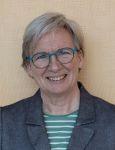I love the way art tugs at my mind and heart. Standing before a powerful work, my internal gears shift and my rational mind, physical senses, and emotional responses seem to slip into the same groove. Unexpected connections bubble up, sparking ideas and making me feel intensely alive.

Kevin Giese’s Original River (foreground) and Brenda Baker’s sculptures (background).
It’s those unexpected connections that make curating exhibitions so juicy. They guide the placement of artwork in the gallery, the relationship between each piece, even the lighting. On occasion, they inspire a sprinkling of extras—“interpretive materials,” as we say in the trade—that offer context and encourage questions. But the extras are a delicate business. Throw in too many, and the exhibit becomes a textbook assignment; too few, and the connections remain opaque.
Miniature logging tools made by Otto Rindlisbacher of Rice Lake between 1930 and 1960.
Lent by Wisconsin Historical Museum.

Logging Scene, Carl Arneson (1877-1959), Oil on pine, before 1957.
Lent by Wisconsin Historical Museum.
LOGJAM was a joy to develop because the connections emerged so organically. When I saw Brenda Baker's Seed Pod, made with buckthorn, autumn olive, and honeysuckle culled during restoration projects, it called to mind a beautiful installation of sewn birchbark that Kevin Giese had created for Milwaukee’s Portrait Society Gallery. About the same time I was given a book of devastating aerial photos of clearcuts that made me want to learn more about the impact of logging in the Upper Midwest. Paul Bunyan and “the pinery boys” are embedded in Wisconsin culture; we all know about the lumberjacks, the fortunes made in timber, and the farmers who struggled to make a living on cutover land. I wondered what that history has taught us, and what state our forests are in today.
Mark Iwinski’s prints made from old-growth stumps
with play structure made by Whole Trees Architecture & Structures.
Soon afterward I stumbled across Mark Iwinski’s prints made from old-growth stumps, and the concept for the show began to take shape. Mark’s work bears witness to the immensity and grandeur of the ancient trees we’ve lost. I felt it was important to temper this difficult message by recognizing local efforts toward better stewardship. Thankfully, there is a wealth of good news to report, like the Menominee Nation’s longterm commitment to sustainable forestry, the USDA Forest Products Lab’s work to identify illegally-harvested timber, and the pioneering sawyers and architects who are promoting urban and regionally grown wood as well as “forest waste” that would otherwise be chipped for paper pulp or mulch.
Drawer of wood samples, lent by USDA Forest Products Laboratory and a
buckthorn tree sample, lent by Whole Trees Architecture & Structures.
Organizing LOGJAM has been a fascinating journey, and I’m grateful for the opportunity to share what I’ve learned—that’s probably the best part of my job! I’m very grateful to Brenda Baker, Kevin Giese, and Mark Iwinski for being willing to share the spotlight with so many curatorial “extras.” I hope that LOGJAM will inspire you to make your own unexpected connections, and reflect on the health of the forests you love.



